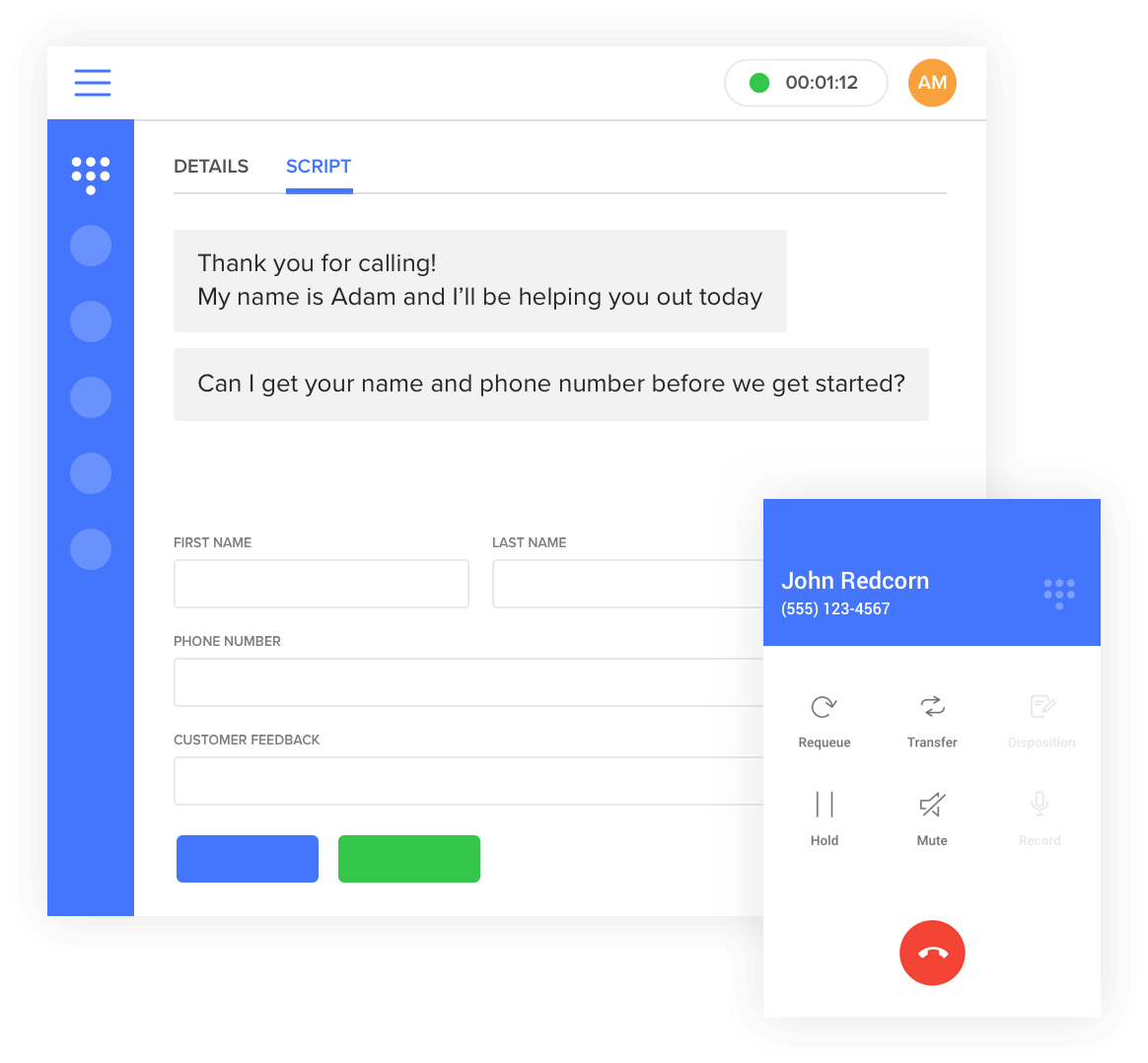In this article, we'll cover:
What is cloud telephony?
Cloud telephony is a type of unified communications as a service (UCaaS), essentially enabling organisations to run a business phone system through their internet connection.
Also commonly known as cloud calling, cloud telephony offers business voice services, run and managed by a third-party operator or host. A cloud phone system, often in the form of a VoIP- based hosted PBX system (voice over internet protocol), carries voice calls as well as messaging, video calls and file sharing all under one unified platform via your business internet connectivity.
Unified communications solutions bring all these communications and collaboration tools together so that your teams can benefit from several different functions all under one roof. UCaaS also means you can integrate your CRM system and other day-to-day tools such as Microsoft office 365 or your Google suite, making your teams more efficient and improving your customer experience for the longer term.

Moving your business phone system to the cloud comes with many benefits, but most prevalent is the ability to streamline your business communications on a broader scale fully. Whether you’re looking to grow y
our team, hire remote team members, or move offices, switching to the cloud is a shrewd, cost-effective move for any business looking for scalability and to improve their team’s agility.
How does cloud telephony work?

On a practical level, cloud telephony works in the same way as any other VoIP service, by converting analogue voice signals into data packets and transmitting them over an internet connection. In the case of cloud telephony, when a user dials a phone number using a VoIP desk phone or softphone, the call is routed by a third-party VoIP service provider.
Cloud telephony eliminates the need to run on-premises, traditional PBX systems. For example, you won’t need to manage your own PBX (private branch exchange), but rather, your cloud system can be web-based or as an application.
Cloud telephony works by using the internet connection to enable users to make and take calls from their desktop or mobile handsets. Adopting cloud telephony means businesses appoint a provider to build, operate, and maintain their servers’ telephony platform.
These providers generally offer a multi-tenant access model which means business users can subscribe to the provider’s range of resources, generally on a month-by-month basis. Business customers essentially subscribe or ‘rent’ remote access to the service via the internet, meaning they outsource the management of any complex technology and eliminate the need to house bulky physical hardware in-house.
Implementing this type of model means that businesses can also eradicate the costs of running an on-premises system such as physical PBXs which can be costly to maintain and provision.
Outsourcing your telephony system’s maintenance doesn’t mean you have to relinquish all control over your phone system though. As your new cloud system is managed in the cloud, your IT teams or team leaders can still manage and administer simple system changes and edits via an online dashboard, allowing full control over your telephone numbers, extensions and call forwarding.
Key benefits of a cloud telephony service
There are several benefits of cloud telephony. In short, cloud technology helps businesses bring their telephony infrastructure into the digital age; simplifying and integrating their business systems to improve overall efficiency. Breaking it down, here are some of our top long-term advantages for modern businesses thinking of implementing a cloud telephony service.
1. Easy implementation
As it doesn’t require on-site hardware, investing in cloud telephony means you can hit the ground running pretty quickly (generally within the space of a few days tops). Eliminating the need to wait for technicians and lengthy phone line instillation, your chosen VoIP provider looks after the implementation and configuration of your new system from start to finish, meaning less hassle for your teams, and less downtime.

2. Simplicity
Not only is your cloud system easy and quick to implement, but it’s also simple to use. A cloud communications system allows you to store and access files, make and receive calls, conduct video conferencing, and message team members using one easy-to-use interface. This eradicates the complexity and inefficiency of keeping notes and information stored across different communications platforms. The centralised storage makes finding a record of past interactions and conversation streams much easier, helping employees to stay focused and on track with day-to-day tasks.
3. Cost efficiency
Cloud telephony helps you to save money on your business communications. Mitigating the need to invest in multiple different tools and solutions such as business SMS, video conferencing, fax and file storage, and cloud communications consolidate multiple platforms’ costs into one single fee. What’s more, with cloud telephony, you won’t experience ‘bill shock’ due to unexpected maintenance payments. Instead, you’ll benefit from predictable, manageable monthly pricing. Businesses looking to get started without an initial hefty outlay on hardware (such as VoIP phones) can use a softphone app with a headset, or mobile apps which allow callers to use the system at a low cost, with better flexibility.
4. Mobility and flexibility
With remote working on the rise, cloud technology has had its chance to shine truly. With a cloud telephone system, employees can access phone lines from wherever they might be working at the time (as long as they have access to the internet). Mobile users and remote workers aren’t limited to just answering or making calls either; they can also edit call routing on the move, set-up call forwarding and access voicemail all while they’re on the road, in a café, or at their kitchen table at home. The agility afforded by a cloud system means it is the ideal solution for teams that regularly work off-site, organisations that allow remote working, or any business looking to grow their team and scale up in an increasingly virtual working environment.
5. Advanced call features
Businesses that choose to invest in cloud telephony also benefit from significant advancements in their calling features. With cloud telephony, you have access to a dashboard, allowing you to manage the following features:
Auto-attendant – helping your customers to connect to the appropriate person or team.
IVR (Interactive Voice Response) – allowing callers to ‘self-serve’ and solve their own query through conversational but automated call management paths.
Call recording helps teams maintain a high quality of service or help you keep a log of your calls, video meetings, and conferences.
Call forwarding – allowing your teams to reduce the number of missed calls.
Video conferencing and screen sharing – to help team members connect face-to-face and conduct more effective meetings.
6. Increased productivity
The built-in features of a cloud communications system are designed to encourage better productivity in the workplace. Advanced call handling features, as well as video conferencing, instant messaging, file sharing and intuitive ‘off the shelf’ or custom-built integrations, allow your employees to truly focus on their important daily tasks without wasting time switching between a patchwork of platforms. Benefitting from multiple functions in one platform helps to truly iron out and streamline day-to-day processes, meaning happier, more engaged employees and better-satisfied customers.

7. Reliability and security
Businesses that select a reputable cloud telephony provider will benefit from improved reliability. Leading providers such as RingCentral will vouch for a 99.999% uptime SLA, meaning you can rest in the knowledge that you’ll be getting the best level of business continuity possible, and you significantly reduce your chances of missing a call. Choosing a provider that prioritises your security is equally important, but partnering with a trustworthy supplier means your customers, calls and your data will be safe and protected from cybercrime.
Cloud telephony vs VoIP
While there is little difference between a cloud telephony system and business VoIP, there is a difference. Almost all cloud telephony solutions use VoIP technology, but a cloud system is just one type of platform that might use VoIP.
Essentially, not all VoIP systems will be run in the cloud. VoIP means that calling data and other communications packets will travel over the internet. Businesses can adopt VoIP technology by opting to host their system using an on-premises PBX or outsource to a cloud provider.
Related Reading: Cloud Communications: Public, Private, and Hybrid
How to Choose a Cloud Telephony Provider (5 Things to consider)
With many providers offering cloud telephony services, it’s important to create a plan to help you shortlist those that fit with your business goals and give the right level of ongoing support for you and your team.
Here are a few of our top tips for selecting, and appointing a cloud telephony provider:
-
Service quality and SLA’s
Look carefully at the SLA (service level agreement) of your provider. An SLA should outline service level objectives, caveats and exclusions and remediation policies and penalties related to the objectives. You’ll want to look for suppliers with an SLA that is clearly outlined, unambiguous and also tangible, so you know who is responsible for which aspects of your system maintenance.
If a provider’s SLA looks too good to be true, ask around; request evidence or case studies to give examples of your provider resolving any issues quickly and in line with their SLA, so that you know they can be trusted to deliver. In essence, to get the best level of reliability from your cloud provider, you’ll want to look for an SLA that promises 99.999% uptime.
-
Technology requirements, features and integrations
First, it’s important to assess the essential requirements of your team. Establish which capabilities are non-negotiable, starting with the very basics before delving into the more advances features of unified communications.
You’ll want to ensure your system has the basic calling functionality required for day-to-day integrations to work well. Assess whether your teams make more calls or receive more inbound calls for example, and does your cloud system need to span multiple office locations? Does it need to account for a global customer base of callers? Consider your customers and your employees’ immediate impact and establish clear objectives on any day-to-day challenges your cloud telephony system will mitigate to make sure these stay front of mind.
Make sure your new system will easily integrate with your CRM, project management tools and platforms such as any Microsoft Office or G-Suite platforms that are used company-wide. You might then want to delve deeper to establish whether your cloud system offers integrations specific to your teams, such as marketing automation platforms.
-
Security and compliance
Before you commit to any particular provider, you’ll want to ensure they value security as much as you do. Check that your supplier offers call encryption, allowing you to use transport layer security (TLS) and secure real-time transport protocol (SRTP) to ensure you’ll get enterprise-grade security throughout your contract.
Do your research to check how any data will be stored, and check any specific compliance needs following your business needs. You’ll want to check that your supplier meets the global standard for security threat responses: ISO/IEC 20071.
-
Vendor lock-in and migration support
While the credentials of your new provider might bowl you over, there will likely come a time when you might, for whatever reason, want to part ways. You’ll want to make sure that process will be as easy for you as possible, to avoid future complications concerning migrating to a new system or supplier. Look at any lock-in clauses and details of before you commit to a supplier.
-
Reputation and financial health
In this digital age, it’s effortless to research the reputation of a potential partner. Rather than simply taking credentials and accolades at face value, look around for unbiased customer reviews, case studies and testimonials to ensure you have chosen a reputable supplier. It’s also important to ensure your know a little about your potential provider’s financial health to ensure that they have a sound, stable foundation you can rely on for the long term.

RingCentral’s Cloud Telephony
Choosing a cloud partner, you can rely on is especially important if you’re investing in cloud telephony. Outsourcing maintenance and upkeep of your phone system to an external provider can be daunting, so taking the time to research your possible suppliers is key.
RingCentral’s cloud PBX service offers enterprise-grade security, an industry-leading 99.999% uptime SLA. The solution is also available in over 40 countries with international phone numbers offered in over 100 countries, allowing global businesses ample resources to grow, and save money on costly IT overheads.
At a time when employees are more likely than ever to be working remotely, RingCentral’s UCaaS public cloud allows for better, more valuable connections, bringing teams together in one easy-to-use platform.
Originally published Jan 25, 2021, updated Mar 22, 2023


